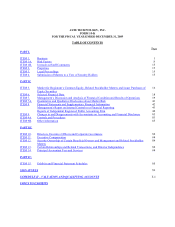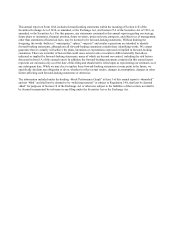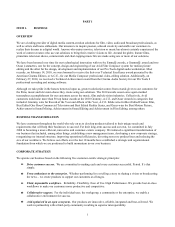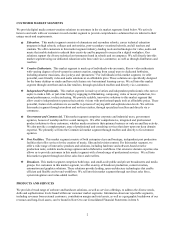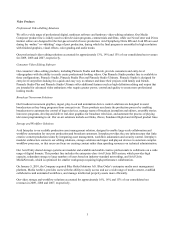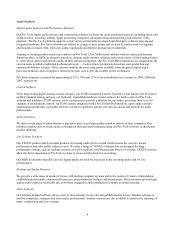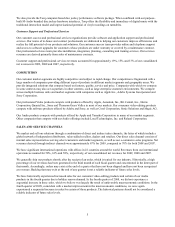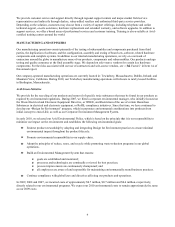Avid 2009 Annual Report Download - page 14
Download and view the complete annual report
Please find page 14 of the 2009 Avid annual report below. You can navigate through the pages in the report by either clicking on the pages listed below, or by using the keyword search tool below to find specific information within the annual report.9
We expect the global economic downturn to continue to have a negative impact on our business, although the
magnitude of that impact is uncertain.
We believe that the global economic downturn negatively affected our revenues and operating results in 2009. Although we
are unable to predict future economic conditions or the magnitude of the downturn’s impact on our business, global
economic activity is expected to remain slow. To the extent our customers’ businesses have been or expect to be negatively
impacted by the economic downturn, we anticipate that they may delay or postpone purchases of our solutions. Of
additional concern, certain of our professional customers rely on credit to finance purchases of our solutions, including
through third-party leasing arrangements that we offer. Credit markets remain constrained by historic standards; to the
extent credit is unavailable, even customers otherwise willing to proceed with purchases might be unable to do so unless or
until they are able to arrange for alternative financing. Additionally, certain of our customers have become insolvent, and
others may become so in the future. To the extent our customers suffer from lack of liquidity or become insolvent, our sales
cycles may lengthen and our accounts receivable collection rates may suffer, which would negatively affect our revenues,
or, in some circumstances, we may have to consider extended or alternative payment arrangements, which could delay
revenue recognition.
We may also be affected to the extent the economic downturn continues to negatively impact our resellers and distributors.
Our resellers and distributors have in some cases, and may in the future, reduce on-hand inventory of our products as a
precaution. The downturn has also caused certain of our resellers and distributors, and may cause others, particularly in the
retail sector, to seek bankruptcy protection. With respect to any reseller or distributor that enters bankruptcy, we may be
unable to collect from that reseller or distributor monies due to us or arrange for the return of unsold inventory.
As the media industry evolves, our customers’ needs, businesses and revenue models will change in ways that may
deviate from our traditional strengths, making our existing products and solutions less relevant.
The media content creation industry is rapidly transforming. Content distribution models and consumption habits have
changed dramatically in just the last five years. With increasing amounts of free content and minimal entry costs for
creation and distribution, our traditional customers’ industries and businesses are changing, and consequently their
relationships with us may change significantly. Our business customers require vendors that can provide them with tools to
help manage a growing number of media assets and distribution channels, while also reducing their costs. Our consumer
customers increasingly look to participate in new ways in this media revolution. Our future success depends on our ability
to develop products that effectively satisfy these demands. Our customers may also seek to pool or share facilities and
resources with others in their industry and engage with providers of software as a service. Open platforms, online
collaboration tools, and cloud computing are replacing the traditional business infrastructures and maintenance, which we
currently provide to them. Traditional advertising channels face competition from web and mobile platforms. Diminished
revenue from traditional advertising will cause some customers’ budgets for purchase of our solutions to decline; this may
be particularly true among local television stations, which in the past have been an important customer segment for us. If
we are unable to stay ahead of or adapt to the changes in our customers’ businesses, our future financial performance will
suffer.
The market segments in which we operate are highly competitive, and our competitors may be able to draw upon a
greater depth and breadth of resources than those that are available to us.
We operate in highly competitive market segments characterized by pressure to innovate, expand feature sets and
functionality, accelerate new product releases and reduce prices. Markets for certain of our products also have limited
barriers to entry. Customers consider many factors when evaluating our products relative to those of our competitors,
including innovation, ease of use, feature sets, functionality, reliability, performance, reputation, and training and support,
and we may not compare favorably against our competitors in all respects. Some of our current and potential competitors
have longer operating histories, greater brand recognition and substantially greater financial, technical, marketing,
distribution and support resources than we do. As a result, they may be able to deliver greater innovation, respond more
quickly to new or emerging technologies and changes in market demand, devote more resources to the development,
marketing and sale of their products, or price their products more aggressively than we can.


